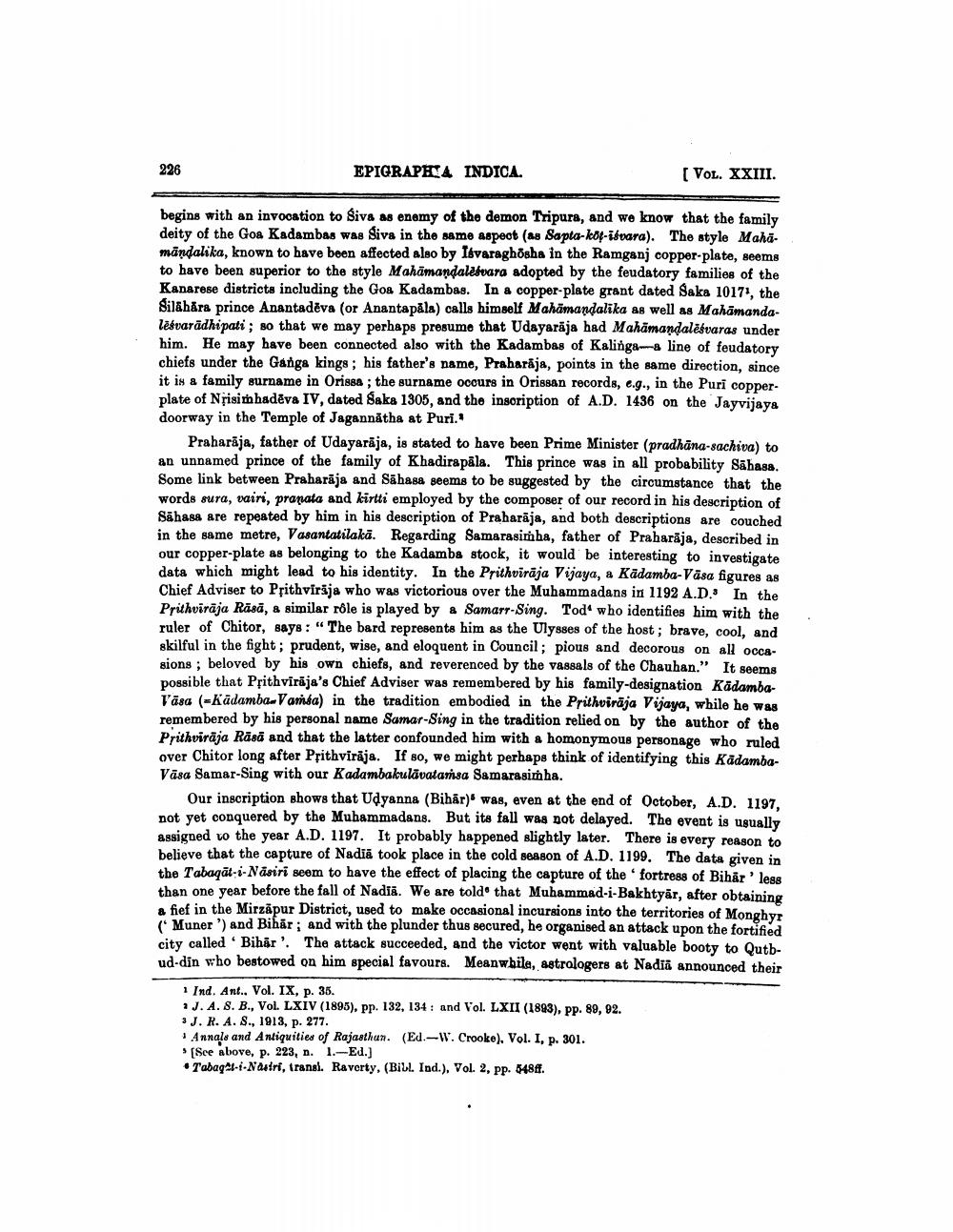________________
226
EPIGRAPHIA INDICA.
[VOL. XXIII.
begins with an invocation to Siva as enemy of the demon Tripura, and we know that the family deity of the Goa Kadambas was Siva in the same aspect (as Sapta-kot-iśvara). The style Mahamandalika, known to have been affected also by Iévaraghōsha in the Ramganj copper-plate, seems to have been superior to the style Mahamandalesvara adopted by the feudatory families of the Kanarese districts including the Goa Kadambas. In a copper-plate grant dated Saka 1017, the Silähära prince Anantadeva (or Anantapala) calls himself Mahamandalika as well as Mahamandalesvaradhipati; so that we may perhaps presume that Udayaraja had Mahamandalesvaras under him. He may have been connected also with the Kadambas of Kalingaa line of feudatory chiefs under the Ganga kings; his father's name, Praharaja, points in the same direction, since it is a family surname in Orissa; the surname occurs in Orissan records, e.g., in the Puri copperplate of Nrisimhadeva IV, dated Saka 1305, and the inscription of A.D. 1436 on the Jayvijaya doorway in the Temple of Jagannatha at Puri."
Praharaja, father of Udayaraja, is stated to have been Prime Minister (pradhana-sachiva) to an unnamed prince of the family of Khadirapala. This prince was in all probability Sahasa. Some link between Praharaja and Sahasa seems to be suggested by the circumstance that the words sura, vairi, pranata and kirtti employed by the composer of our record in his description of Sahasa are repeated by him in his description of Praharaja, and both descriptions are couched in the same metre, Vasantatilaka. Regarding Samarasimha, father of Praharaja, described in our copper-plate as belonging to the Kadamba stock, it would be interesting to investigate data which might lead to his identity. In the Prithviraja Vijaya, a Kādamba-Väsa figures as Chief Adviser to Prithviraja who was victorious over the Muhammadans in 1192 A.D. In the Prithviraja Rāsā, a similar rôle is played by a Samarr-Sing. Tod' who identifies him with the ruler of Chitor, says: "The bard represents him as the Ulysses of the host; brave, cool, and skilful in the fight; prudent, wise, and eloquent in Council; pious and decorous on all occasions; beloved by his own chiefs, and reverenced by the vassals of the Chauhan." It seems possible that Prithviraja's Chief Adviser was remembered by his family-designation KadambaVasa (-Kadamba-Vaméa) in the tradition embodied in the Prithviraja Vijaya, while he was remembered by his personal name Samar-Sing in the tradition relied on by the author of the Prithviraja Räsä and that the latter confounded him with a homonymous personage who ruled over Chitor long after Prithviraja. If so, we might perhaps think of identifying this KadambaVāsa Samar-Sing with our Kadambakulāvatamsa Samarasimha.
Our inscription shows that Udyanna (Bihar) was, even at the end of October, A.D. 1197, not yet conquered by the Muhammadans. But its fall was not delayed. The event is usually assigned to the year A.D. 1197. It probably happened slightly later. There is every reason to believe that the capture of Nadia took place in the cold season of A.D. 1199. The data given in the Tabaqat-i-Nasiri seem to have the effect of placing the capture of the fortress of Bihar' less than one year before the fall of Nadia. We are told that Muhammad-i-Bakhtyär, after obtaining a fief in the Mirzapur District, used to make occasional incursions into the territories of Monghyr (Muner') and Bihar; and with the plunder thus secured, he organised an attack upon the fortified city called Bihar'. The attack succeeded, and the victor went with valuable booty to Qutbud-din who bestowed on him special favours. Meanwhile, astrologers at Nadia announced their
1 Ind. Ant.. Vol. IX, p. 35.
a J. A. S. B., Vol. LXIV (1895), pp. 132, 134: and Vol. LXII (1893), pp. 89, 92.
3 J. R. A. S., 1913, p. 277.
Annals and Antiquities of Rajasthan. (Ed.-W. Crooke), Vol. I, p. 301.
[Sce above, p. 223, n. 1.-Ed.]
Tabagt-i-Nasiri, transi. Raverty, (Bibl. Ind.), Vol. 2, pp. 548ff.




